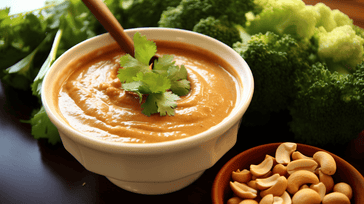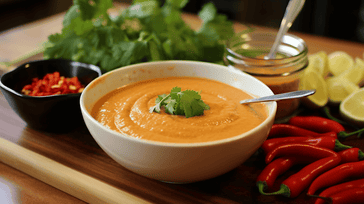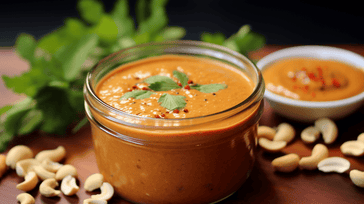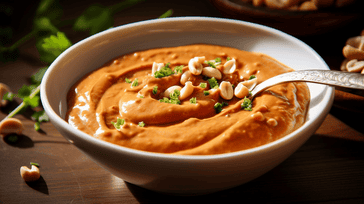- 21 September, 2025
- 57,833 Views

If you're a fan of Thai cuisine, you're likely familiar with the mouthwatering flavors of Thai Peanut Sauce. This delectable sauce is a staple in Thai cooking, known for its tangy, nutty, and slightly sweet taste. It's hard not to fall in love with this versatile sauce that can be used in a variety of dishes, from dipping sauces to stir-fries.
In this article, we'll take a closer look at the essence of Thai Peanut Sauce, exploring its traditional ingredients and the benefits of making it at home. We'll also explore how to add a spicy twist to the sauce with the addition of chili peppers, and highlight its perfect pairing as a dipping sauce for spring rolls. Furthermore, we'll provide tips on how to incorporate Thai Peanut Sauce into your stir-fry dishes, and showcase its versatility beyond traditional Asian cuisine.
Whether you're new to the world of Thai Peanut Sauce or a seasoned pro, this article will provide valuable insights and tips on how to perfect your sauce-making skills and take your culinary game to the next level. So, let's dive in and uncover the magic of this irresistible sauce.
Exploring the Essence of Thai Peanut Sauce
Thai Peanut Sauce is a popular condiment that has gained recognition globally for its flavorful characteristics. Known for its nutty, sweet, and spicy taste, it has become a versatile sauce used in various dishes.
The unique essence of Thai Peanut Sauce comes from its authentic recipe, which includes roasted peanuts, coconut milk, soy sauce, lime juice, brown sugar, and Thai chili peppers. These ingredients create a sauce that is creamy in texture, bold in flavor, and highly addictive.
Homemade Peanut Sauce
While it is readily available in stores, nothing compares to the taste of homemade Thai Peanut Sauce. Making it from scratch allows for customization to suit individual preferences and dietary restrictions. For example, using low-sodium soy sauce and light coconut milk can make the sauce healthier without compromising its flavor.
But making it at home can also be challenging. The key to achieving an authentic taste lies in balancing the flavors. Too much lime juice can make it sour, while too much brown sugar can make it overly sweet. Achieving the perfect blend takes practice and experimentation.
Thai Peanut Sauce Ingredients
Thai Peanut Sauce can be made with a variety of ingredients, depending on personal preference. Some variations include the use of honey or maple syrup instead of brown sugar, or almond butter instead of peanuts for a nut-free alternative.
| Ingredients | Quantities |
|---|---|
| Roasted peanuts | 1 cup |
| Coconut milk | 1 can (14 oz) |
| Soy sauce | 3 tablespoons |
| Lime juice | 2 tablespoons |
| Brown sugar | 2 tablespoons |
| Thai chili peppers | 2-3 peppers |
These ingredients form the base of the sauce and can be adjusted to suit individual preferences. For a spicier version, more chili peppers can be added, while reducing the amount of brown sugar can create a less sweet version.
A Taste of Spiciness: Adding a Kick to Thai Peanut Sauce

Thai Peanut Sauce is already bursting with complex flavors, but spicing things up can add a whole new dimension to your dish. By adding chili peppers to your peanut sauce, you can create a spicy version of this beloved condiment that will ignite your taste buds.
| Type of Chili Pepper | Heat Level | Flavor Profile |
|---|---|---|
| Thai Bird's Eye Chili | Very Hot | Fruity, slightly sour |
| Jalapeño | Moderate | Mild, slightly sweet |
| Serrano | Hot | Bright and grassy |
There are several types of chili peppers you can use to add heat to your peanut sauce, each with its own unique flavor profile. Thai Bird's Eye Chili is the most authentic option, as it is commonly used in traditional Thai cuisine. However, if you prefer a milder spice level, jalapeños or serranos can be good alternatives.
When making spicy Thai Peanut Sauce, it's important to balance the heat with other flavors to prevent the sauce from being overpowering. Adding a little bit of sugar or honey can help balance the spice, while also providing a touch of sweetness to the sauce. You can also adjust the amount of chili pepper based on personal preference, starting with a small amount and building up gradually.
Spicy Thai Peanut Sauce is perfect for dipping spring rolls or drizzling over stir-fried noodles and vegetables. Its bold and tangy flavors will add a fiery kick to any dish, making it a must-try for anyone who loves to experiment with spicy cuisine.
The Perfect Accompaniment: Thai Peanut Sauce for Spring Rolls
When it comes to dipping sauces for spring rolls, Thai Peanut Sauce is a clear winner. Its tangy and nutty flavors perfectly complement the crispy texture of spring rolls, offering a delightful taste experience.
The best part is that making this sauce is incredibly easy. You can either opt for a store-bought version or make it at home using our authentic Thai Peanut Sauce recipe.
Simply whisk together peanut butter, soy sauce, lime juice, brown sugar, garlic, and chili paste until smooth. You can adjust the spice level by adding more or less chili paste according to your taste preferences.
For an even richer flavor, consider adding some chopped peanuts to the sauce. This will give the sauce some added texture and make it even more delicious.
Stir-Fry Sensations: Enhancing Your Dish with Peanut Sauce

If you're looking to add a burst of flavor to your stir-fry dishes, Thai Peanut Sauce is the perfect solution. This versatile sauce not only brings a unique taste to the mix, but it also offers a creamy texture that complements stir-fries nicely.
Here are some tips for incorporating Thai Peanut Sauce into your stir-fry recipes:
- Add the sauce at the end of the cooking process to prevent it from separating or becoming too thick.
- Start with a small amount of sauce and gradually add more as you taste and adjust the seasoning.
The ideal peanut sauce for stir-fries should strike a balance between sweet, sour, salty, and spicy flavors. Here are some flavors that you can mix and match to create the best peanut sauce for your stir-fry:
| Flavors | Description |
|---|---|
| Soy Sauce | Brings a salty, umami taste to the dish. |
| Lime Juice | Provides a sour flavor that balances out the sweetness of the sauce. |
| Honey | Adds a touch of sweetness to the dish. |
| Garlic | Enhances the depth of the flavors and brings a hint of sharpness. |
| Ginger | Offers a warm, zesty taste that pairs well with vegetables and meats. |
| Chili Peppers | Adds a spicy kick to the sauce. |
Experiment with Different Ingredients
The beauty of Thai Peanut Sauce is that it's a versatile sauce that can be easily customized according to your taste preferences. So, don't be afraid to experiment with different ingredients and discover new flavors.
Here's a recipe for easy stir-fry with Thai Peanut Sauce:
"In a large wok or skillet, stir-fry your choice of meat or vegetables until cooked. Add a generous dollop of Thai Peanut Sauce and stir until evenly distributed. Serve hot with rice or noodles."
The possibilities are endless, so unleash your creativity and enjoy the many flavors of Thai Peanut Sauce in your stir-fry dishes.
The Versatility of Thai Peanut Sauce
Thai Peanut Sauce is a deliciously tangy and spicy sauce that can be used beyond traditional Asian dishes. Once you have mastered the art of making your own homemade Thai Peanut Sauce, the possibilities are endless!
Here's a quick and easy recipe for making Thai Peanut Sauce:
| Ingredients | Directions |
|---|---|
|
|
Thai Peanut Sauce can be used as a dipping sauce for vegetables, skewers, or spring rolls. It can also be used as a marinade for chicken, shrimp, or tofu, adding a unique flavor to your dishes. You can also add it to stir-fry dishes or noodle bowls, giving them a delicious twist!
The beauty of Thai Peanut Sauce lies in its versatility, and its ability to complement various cuisines. For example, you can use it as a topping for burgers or sandwiches, or even as a dressing for salads!
So, go ahead and experiment with Thai Peanut Sauce, and discover the endless possibilities it has to offer!
Elevate Your Culinary Skills: Mastering Thai Peanut Sauce

If you're looking to add an authentic Thai flavor to your dishes, mastering homemade Thai Peanut Sauce is a must. While the sauce may seem complex, with a few tips and tricks, you can elevate your culinary skills with ease.
To achieve an authentic taste, it's important to balance the four key flavors of Thai cuisine: sweet, salty, sour, and spicy. Here are some tips to help you perfect your homemade Thai Peanut Sauce:
| Tip | Description |
|---|---|
| Start with quality ingredients | Using fresh, high-quality ingredients is key to achieving an authentic taste. Opt for natural peanut butter, fresh lime juice, and high-quality soy sauce for the best results. |
| Adjust the spice level | Thai Peanut Sauce is typically spicy, but the level of heat can be adjusted to personal preference. Experiment with different types of chili peppers and the amount used to find your perfect level of spice. |
| Balance the flavors | Thai Peanut Sauce should have a balance of sweet, salty, sour, and spicy flavors. Adjust the amount of sugar, soy sauce, lime juice, and chili peppers to achieve the ideal balance of flavors. |
| Explore variations | Once you've mastered the basic recipe, try experimenting with different variations. Consider adding coconut milk, ginger, garlic, or lemongrass to create unique flavor combinations. |
By following these tips, you can elevate your culinary skills and impress your guests with the authentic taste of homemade Thai Peanut Sauce.
The Allure of Peanuts and Chilis: Behind the Magic of Thai Peanut Sauce
Thai Peanut Sauce is a delectable blend of various ingredients, but the star of the show is undoubtedly the peanuts and chili peppers.
The peanuts deliver an earthy, nutty flavor that is rich in protein and healthy fats. They are a staple in Thai cuisine, and their consumption dates back to ancient times. Peanuts offer a slew of health benefits, including a lower risk of heart disease and improved digestion. Additionally, their high-fat content adds creaminess to the sauce, giving it a smooth texture.
The chili peppers, on the other hand, provide a spicy kick that enhances the sauce's overall flavor. Thai cuisine is well-known for its love of spice, and chili peppers are a critical component of many traditional dishes. There are several different types of chili peppers that can be used in Thai Peanut Sauce, including bird's eye chili, jalapenos, and Thai chili. Each type has a unique flavor profile and heat level, which can be adjusted according to individual preferences.
When combined, the peanuts and chili peppers create a harmonious balance of flavors in the Thai Peanut Sauce. This balance is further complemented by the other ingredients, which include soy sauce, garlic, ginger, and lime juice.
“The combination of peanuts and chili peppers is what makes Thai Peanut Sauce irresistible. It's a beautiful fusion of flavors that work exceptionally well together,”Frequently Asked Questions about Thai Peanut Sauce
Thai Peanut Sauce is a popular condiment with a unique blend of sweet, sour, and spicy flavors. Here are some of the most frequently asked questions about this delicious sauce:
1. Is Thai Peanut Sauce vegan?
Most Thai Peanut Sauce recipes are vegan, but it is always best to check the ingredients before consuming. Some recipes may contain fish sauce or shrimp paste, which are not vegan-friendly.
2. Can I substitute peanut butter for peanuts?
Yes, you can use peanut butter as a substitute for peanuts, but the flavor may be slightly different. Make sure to use natural peanut butter without added sugar or salt for a healthier and more authentic taste.
3. How long can I store Thai Peanut Sauce?
Homemade Thai Peanut Sauce can last up to two weeks if stored in an airtight container in the refrigerator. Commercially prepared sauces may have preservatives and a longer shelf life, but it's always best to check the label.
4. What can I serve Thai Peanut Sauce with?
Thai Peanut Sauce is a versatile condiment that goes well with a variety of dishes, including spring rolls, satay skewers, noodles, stir-fries, and salads. It can also be used as a marinade for grilled meats or tofu.
5. How can I adjust the spice level of Thai Peanut Sauce?
The spice level of Thai Peanut Sauce can be adjusted by adding more or fewer chili peppers or using a milder or spicier variety. To reduce the heat, you can also add a sweetener such as honey or sugar.
6. Can I freeze Thai Peanut Sauce?
Yes, Thai Peanut Sauce can be frozen for up to three months. Make sure to store it in an airtight container and thaw it in the refrigerator before using.
Now that you have all the answers, it's time to unleash the magic of Thai Peanut Sauce in your cooking!
Conclusion
In conclusion, Thai Peanut Sauce is a truly magical condiment that can elevate any dish, from spring rolls to stir-fries to sandwiches. With its unique combination of tangy, spicy, and nutty flavors, it offers a taste experience unlike any other.
Whether you choose to make your own authentic sauce or experiment with variations that suit your personal preferences, the versatility of Thai Peanut Sauce makes it a must-try for any food lover.
We hope this article has provided you with valuable insights into the world of Thai Peanut Sauce, from its traditional ingredients and health benefits to its endless uses in the kitchen. We encourage you to unleash your creativity and savor the flavor of this irresistible sauce.
